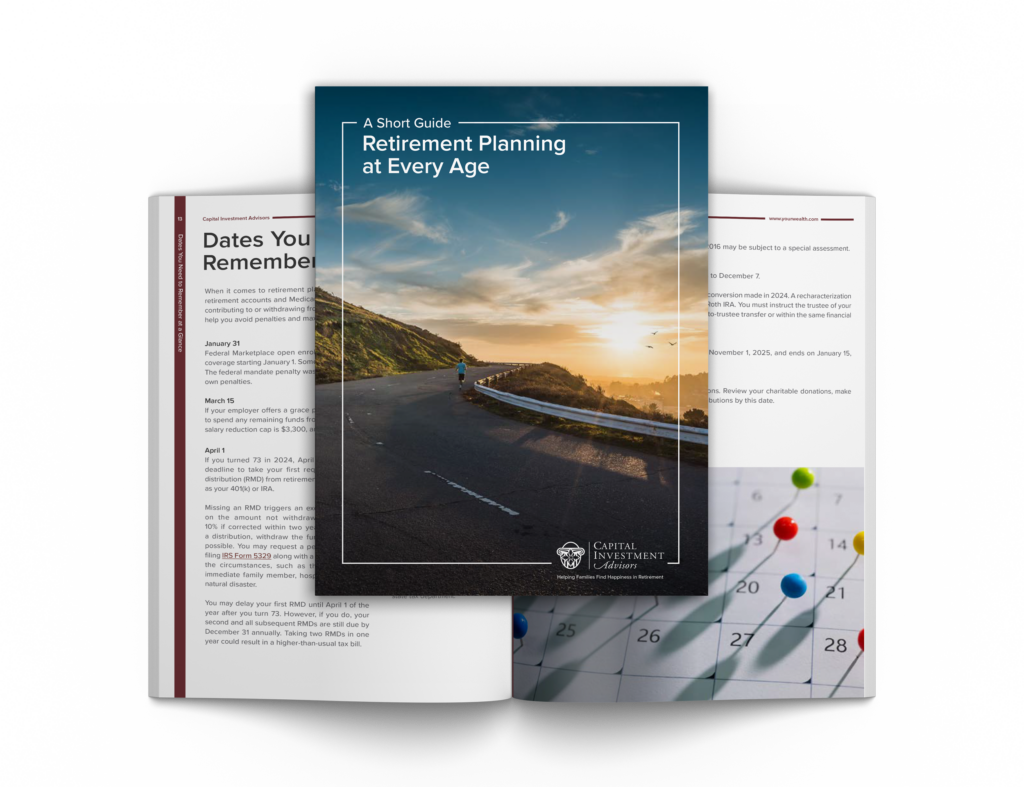Tis’ the season for W-2’s, 1040’s, Schedule C’s, 1099’s, capital gains, and all the rest. Yes, it’s tax season, yet again, and no matter how many challenges we’ve seen this year with the stock market, interest rates, and egg prices, the government still wants its money.
While others may kneel before the tax gods and pray for mercy, I gather my tax documents and face whatever direction Ed Slott is standing. Because when it comes to IRA advice, in my opinion he is Mecca, and the rest of us are but weary pilgrims seeking shelter.
A nationally recognized IRA distribution specialist, professional speaker, television personality, and best-selling author, Ed Slott was called one of the best sources for IRA advice by the Wall Street Journal. His latest books, The New Retirement Savings Time Bomb and Ed Slott’s Retirement Decisions Guide: 2022 Edition, are valuable tools for this tax season and beyond.
When interviewing him for my Retire Sooner podcast, I hoped to find some actionable steps for Americans looking to become more competent taxpayers. As always, he delivered.
Roth IRAs vs. Traditional IRAs and 401(k)s
Traditional IRAs and 401(k)s allow people to deduct their contributions from that year’s taxes. But, when it’s time to pull the money out, the tax bill can pack quite a punch. As Ed tells it, “We put money in 401(k)s and IRAs and we made that deal with the devil, with the government, saying ‘Alright, we’ll get a little tax break upfront each year.’ But then, as with any deal with the devil, there’s a day of reckoning.”
That specific day of reckoning was added to the calendar when the Secure Act 2.0 Act was signed into law in December of 2022. The new law raises the RMD age to 73 beginning in 2023. In 2033, the RMD age will further increase to 75. Individuals who were born between 1951 and 1959 will need to start their RMDs after age 73. Those born in 1960 or later can delay RMDs until after age 75. So why does the government care whether or not you pull out your money? Because they get to tax it! Or, as Ed put it, “That’s the date that the government has determined they are sick and tired of waiting for you to drop dead!”
Each time you take a deduction for retirement, you’re, in essence, receiving a tax loan to be paid back at some future date, most likely at a higher rate. Ed is not a fan of this option. He avoids it whenever possible and even compares the dynamic to Pig Pen from the Peanuts cartoon, who was constantly followed by an ominous dirt cloud. So how does one avoid Pig Pen’s dirty fate? One of the best ways, according to Ed, is to focus on Roth IRAs. “Every young person should only be doing Roth IRAs or Roth 401(k)s at work. They have the ability to start from dollar one, building a retirement account that’s absolutely tax-free. So all the growth, all the compounding, will be 100 percent theirs.”
As a quick review, a Roth IRA is an individual retirement account that offers tax-free growth and tax-free retirement withdrawals. Of course, you can’t deduct the deposits, but folks aged 59 ½ or older, who have owned their account for at least five years, can withdraw funds without owing any federal taxes.
If Roth IRAs are so great, why would anyone bother with other retirement accounts? Well, there are limits and stipulations. For 2023, the total contributions can’t exceed $6,500 ($7,500 if you’re 50 or older). There are also income restrictions. For example, single-filing taxpayers can’t have earned more than $144,000 in 2022 and $153,000 in 2023. For those married and filing jointly, those numbers are $214,000 and $228,000, respectively.
From time to time, I get anxious calls from radio listeners, worried that the government will change the rules down the road. In other words, they don’t want to go the Roth IRA route only to have the tax perk rug pulled out from under them upon retirement. Can they trust that this won’t happen? “The answer is absolutely not!” says Ed. “You can’t trust these guys as far as you can throw them. Tax laws are written in pencil.” But that doesn’t matter, he exclaimed. “It’s here now! Take advantage of it now!”
Does that mean Ed would convert traditional IRAs to Roth? You bet it does.
Now, let’s say you’re already in a high tax bracket, paying 35 percent per year. Is it wise to convert your traditional IRA or old 401(k) into a Roth, knowing that every penny you convert is taxable and contributes to your overall income? The answer is that a tax projection should be run with a CPA to determine how much the Roth conversion would raise your overall effective income rate. In general, my opinion is that a tax increase higher than about 24 percent might make the Roth less attractive, despite its benefits.
Look, Ed’s not a sadist. He loves Roth IRAs but doesn’t want you going broke to get one. In some cases, a moderate approach of more minor, annual conversions is more appropriate. However, Ed puts his own money where his mouth is. Back in 2010, when a new tax law made it possible, he “converted everything: lock, stock, and barrel!”
What about Social Security? Some folks in their 60s worry that the conversion would cause a spike in income and make it taxable. Ed believes that’s a non-issue because Social Security thresholds are so low that it’s already taxable for most people.
What about Medicare premium surcharges? Ed gets an earful from people about the possibility of those increasing. “If that’s going to make you angry, do the conversion anyway because I’d rather have you be angry one year than be angry for the rest of your life. Because if you don’t do it and you do nothing, that account is going to grow, grow, grow, and [at your RMD age] you’ll be forced to take it out, and the very thing that makes you angry is going to happen every year.”
For those who already have enough money to retire comfortably, converting to a Roth IRA can serve as a pre-paid tax gift for children and grandchildren. For instance, Ed has a sixty-seven-year-old doctor-client. She’s still earning a nice income but has millions in her traditional IRA from all the 401(k)s rolled over in her career. Each year she converts about a million dollars to her Roth IRA. But, she told him, “I’ll never need any of that money. I’m doing it because it’s going to my grandchildren.”
The Sweet Spot
Some of my Retire Sooner podcast listeners might need to use a portion of their IRA money to stop working. So, I wanted Ed to walk us through some of the crucial ages of retirement planning. He calls the time between ages 59 and ½ and 73—the retirement sweet spot.
Touching a retirement account before age 59 and ½ would mean a 10 percent early withdrawal penalty. That’s a dealbreaker to Ed. But on the other end of the spectrum, mandatory distributions kick in at age 73, which is why the time between is an oasis of planning. This sweet spot is when you get more of the carrot and less of the stick. Ed implores you to take advantage of it.
Life Insurance
Ed believes the tax exemption for life insurance is one of the most significant single benefits in the tax code, and most people don’t realize it. “You might look at a permanent life insurance policy as a super-duper Roth that has a giant death benefit, all tax-free without all the government tax rules. Because of that, it’s another prudent option for people who want to leave bigger legacies to their children and grandchildren.”
Bottom Line
The bottom line is there is no one size fits all with retirement planning. Take the time now to speak to your personal tax advisor to determine what is right for you.
It’s critical to face retirement planning head-on rather than succumbing to avoidance, procrastination, and regret. Spend the time you need to select the most tax-efficient options.
“The biggest mistake is not addressing the planning,” Ed told me. “They’ve done all the working, building, saving, and investing. They look at their IRA or 401(k) and say, ‘Well, I’ve saved all I’ll ever need for retirement.’” Ed says this is a huge mistake.
You worked hard for your money. So why jeopardize the fruits of that labor with a short-sighted retirement plan? Instead, keep your eye on the ball so you and your loved ones can experience all the joy you’ve earned.
*Listen to my full discussion with Ed Slott.
This information is provided to you as a resource for informational purposes only and is not to be viewed as tax advice or recommendations. This information is being presented without consideration of the tax or investment objectives, risk tolerance, or financial circumstances of any specific investor and might not be suitable for all investors. This information is not intended to, and should not, form a primary basis for any decision that you may make. Always consult your own legal, tax, or investment advisor before making any investment/tax/estate/financial planning considerations or decisions. The views and opinions expressed are for educational purposes only as of the date of production/writing and may change without notice at any time based on numerous factors, such as market or other conditions.











